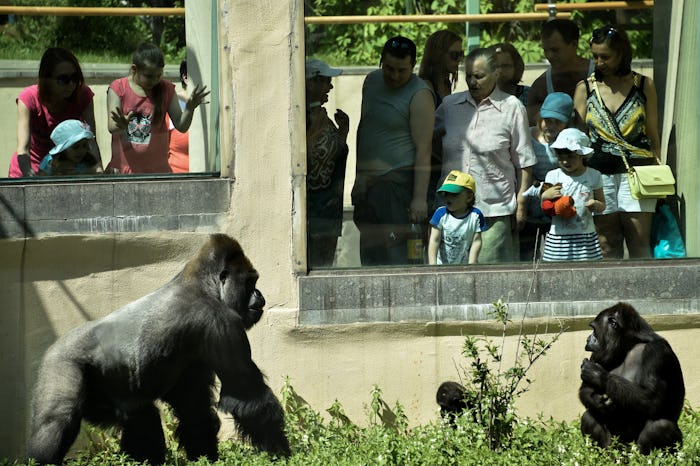
How Many Zoo Accidents Are There Per Year? They're Rare & Largely Avoidable
Public outrage over the killing of Harambe, the 17-year-old western lowland gorilla, at the Cincinnati Zoo on Saturday has everyone speculating about what could have been done differently and who is to blame for the tragic accident. Many have argued that the fault lies squarely on the child's parents, while other blame the zoo. But wherever your opinion falls in this debate, there's one thing that the incident has made very clear: Zoo safety is incredibly important, because the reality is that accidents do happen, no matter how hard zoo officials work to prevent them. How many zoo accidents are there per year? The good news, according to CNN, is that accidents are very rare. But as Harambe's death taught all of us, preventing zoo accidents is something that both workers and visitors need to take extremely seriously.
As parents, it can be really easily to think of the zoo as a fun place where kids get to see animals up close and personal, but the truth is that zoos are much more than that. Zoos are captive habitats for a variety of (sometimes very dangerous) wild animals, and many of them work very hard first and foremost to protect these animals from extinction instead of just showing them off to the public. This type of work is important (western lowland gorillas like Harambe, for example, are considered critically endangered, according to the World Wildlife Foundation), but it means that visitors need to understand that allowing the animals to thrive in captivity means they need to be more mindful than they may realize about the risks involved.
According to CNN, animal advocacy group Born Free reports that there have been 256 injuries in zoos due to animal attacks over the past 26 years, resulting in 33 deaths. These would include injuries from situations like the one involving Harambe, where a child falls into an enclosure, but most most often involve zookeepers or trainers. Given the number of people who actually visit zoos every year, that means zoo-related accidents don't happen very often. But as the world saw last week, when they do happen, the outcome is rarely a good one.
According to The Dodo, the shift from moving zoos away from simply being places where animals were kept in secure cages, to allowing them to live in enclosures that are more representative of what they would see in the wild, has meant that those enclosures have actually become easier for visitors to breach. As The Detroit Zoo's executive director and CEO Ron L. Kagan told The Dodo,
If we look back 40 or 50 years, you'd go to zoos and see animals behind bars. You'd see them in a way that they're imprisoned, truly imprisoned, which means they're protected and people are protected.
But now that the goal is to provide "naturalistic and immersive" exhibits like the one Harambe lived in, Kagan said it has become "almost impossible to prevent" people who intend on breaching an enclosure from getting inside.
According to the Daily News, witnesses from the Cincinnati Zoo incident have said that the boy told his mother that he wanted to go into the water where the gorilla was — and then he did when her back was turned. And it certainly wouldn't be the first time such a thing has happened.
Only a few weeks before the Cincinnati Zoo incident, according to National Geographic, a drunk man jumped into a lion exhibit in at the Nehru Zoo Park in India (he managed to make it out unscathed), and two days before that, a suicidal 20-year-old man also jumped into a lion exhibit at a zoo in Chile, resulting in two lions being shot by zoo officials. And it's not just exotic animals unwitting visitors are getting too close with: At the Yeshanko Wildlife Zoo earlier in the month, both a visitor and a zookeeper were drowned by a walrus, after the visitor breached the enclosure and tried to take selfies with the animal (I am not even making that up.)
Of course, there are accidents too. According to CNN, a 2-year-old boy fell into a cheetah exhibit at the Cleveland Metropark Zoo in April 2015 after his parents held him up over the barricade to get a better view, and that same year, a 17-year-old high school senior was mauled to death while having a senior portrait taken with a restrained Siberian tiger at a Kansas animal sanctuary. Even when the outcome is not nearly as life-threatening, there are plenty of examples of zoo visitors not properly understanding the risks involved in zoo exhibits: YouTube is full of "funny" and "cute" videos involving children and zoo animals that could have ended horrifically if something had gone wrong (note to parents: teach your kids not to tease the animals!).
The bottom line, it seems, is that, statistically, zoos are incredibly safe for visitors. But they are not without risk, and parents especially need to be aware of those risks when they bring their children to see zoo animals up close. Even though the likelihood of a tragic accident happening to you or your child is very low, if there's anything that's become incredibly clear after Harambe's death, it's that nobody wants to know what it's like to walk in the shoes of the little boy's mother and father.